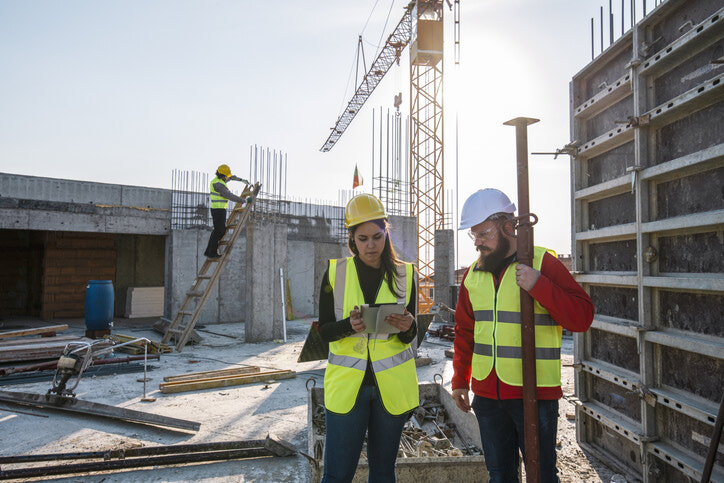Article Overview:
This article explains what surveying in construction means and why it is essential for project accuracy and accountability. It details how construction site surveys connect design intent to physical execution through layout control, elevation checks, volumetric analysis, and as-built verification. Readers will learn how modern land surveying equipment, including total stations, GNSS receivers, UAVs, and 3D scanners, enables faster, more precise data collection. By exploring how surveyors measure, map, and monitor every stage of construction, the article highlights surveying’s critical role in reducing rework, maintaining compliance, and keeping complex projects on time and within budget.
Every successful project begins with precise measurements and reliable control. Without them, even the most detailed design cannot be translated into the real world with confidence. For project managers, understanding what is surveying in construction is essential because it directly impacts accuracy, compliance, and workflow efficiency. Surveying is the link between the drawing board and the job site, ensuring that construction is executed exactly as planned.
What Is a Construction Site Survey?
A construction site survey is the process of measuring, mapping, and verifying land and structural elements to support building activities. Surveyors establish reference points and benchmarks that guide everything from excavation to final turnover. Using advanced land surveying equipment such as total stations, GPS systems, and 3D scanners, they capture the physical conditions of a site and align them with engineering designs.
This process ensures that every foundation, utility, and structural element is positioned correctly. It also identifies potential site challenges before work begins, saving time and reducing the likelihood of costly rework.
How Surveying Connects Design to Execution
Surveying in construction is about translating design intent into precise physical placement. Engineers may create detailed digital drawings, but surveyors ensure those designs are accurately staked out in the field. Control points mark where key features such as walls, anchor bolts, or underground utilities must be located.
Surveyors also verify progress throughout construction. By measuring elevations, alignments, and dimensions, they ensure that what is being built matches the approved plans. This continuous verification provides project managers with confidence that execution stays on track.
Core Functions of Surveying in Construction
Surveyors contribute across all stages of a build, ensuring accuracy from the earliest layout to final documentation. Their work typically involves:
Establishing layout and control points for excavation, foundations, and structural placement
Surveyors set precise reference markers, often called control points, that guide excavation crews, foundation contractors, and structural installers. These points ensure that every element of the project is positioned exactly where the design intends. In the context of what is a construction site survey, this step is the bridge between plans on paper and physical work on the ground.
Performing elevation checks to confirm grading, drainage, and vertical alignment
Elevation checks are used to verify that site grading and vertical placement meet engineering and drainage requirements. Surveyors use specialized land surveying equipment such as total stations and GNSS receivers to confirm that the site slopes correctly for water runoff and that vertical structures align with design specifications. This prevents issues like pooling water, uneven floors, or misaligned building frames.
Measuring cut-and-fill quantities for earthworks and volumetric calculations
Surveyors calculate how much soil must be excavated (cut) or added (fill) to bring a site to the required grade. These volumetric calculations are critical for budgeting, scheduling, and equipment allocation. When managers ask what is surveying in construction, this function highlights the role of surveyors in cost control and resource planning, as it directly impacts earthmoving efficiency.
Monitoring construction progress with as-built surveys to confirm compliance
As-built surveys document the actual conditions of a project compared to the design. This process allows project managers to confirm that work has been executed correctly and remains in compliance with regulatory standards. These surveys are also valuable for turnover packages, providing owners and inspectors with accurate records that reduce the risk of disputes or rework.
Incorporating UAV mapping and 3D laser scanning for faster, more detailed site intelligence
Modern surveyors use UAVs and 3D scanners to capture site data with speed and precision that traditional methods cannot match. UAV mapping produces high-resolution aerial imagery and topographic models in a fraction of the time. Laser scanning collects millions of points in minutes, creating accurate 3D models for clash detection and quality assurance. For project managers, these tools demonstrate how land surveying works in today’s fast-paced construction environments by providing actionable data in near real time.
Together, these functions create the foundation for accurate, efficient, and compliant construction activities that keep projects on time and within budget.
The Role of Land Surveying Equipment
Modern surveying relies on advanced instruments that enhance both speed and precision far beyond traditional methods. Total stations and GNSS receivers allow surveyors to set accurate control points across large or complex sites, providing the foundation for all subsequent layout work. UAVs deliver high-resolution aerial imagery and mapping in a fraction of the time it would take crews to complete the same task on the ground, making them especially effective for large-scale earthworks or remote locations. Laser scanners add another level of detail by capturing millions of data points in minutes, producing highly accurate 3D models that support clash detection, as-built verification, and quality control.
For project managers, these technologies translate into timely, field-ready information that improves oversight and coordination. Instead of waiting days for survey results, managers can make decisions with near real-time data. Just as importantly, the integration of survey outputs into digital design and construction workflows reduces uncertainty and keeps every stakeholder aligned. This combination of speed, precision, and seamless data integration gives project teams the confidence to execute work accurately, on schedule, and with fewer risks of costly rework.
Why Surveying Is Critical for Project Accuracy
Accuracy is not a luxury in construction, it is a necessity. A misplaced foundation, a miscalculated elevation, or an overlooked grading issue can trigger delays, change orders, and compliance failures. Surveying mitigates these risks by providing the verified data needed to keep work aligned with design and regulatory standards.
Surveying also ensures that documentation is thorough and transparent. From boundary records to as-built surveys, these deliverables provide proof of compliance for regulators and owners. For project managers, this documentation supports accountability and streamlines turnover.
Surveying as the Backbone of Reliable Construction
To answer the question what is surveying in construction: it is the process that makes accurate building possible. A construction site survey establishes the framework that connects design intent to real-world execution. With layout, elevation checks, volumetric analysis, and advanced UAV or 3D data capture, surveyors provide the precision project managers need to keep schedules on track and avoid costly rework.
If your project requires accurate, field-ready surveying that integrates seamlessly into construction workflows, contact Apex Geomatics today for proven expertise and reliable results.


